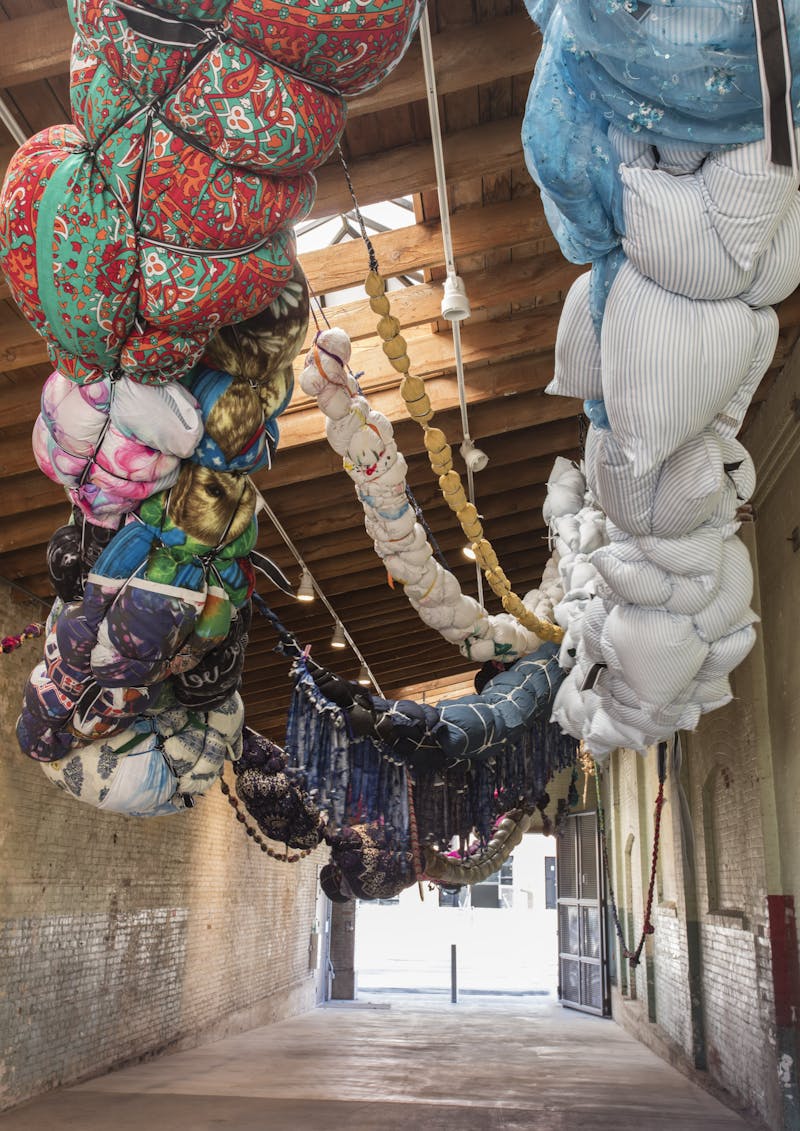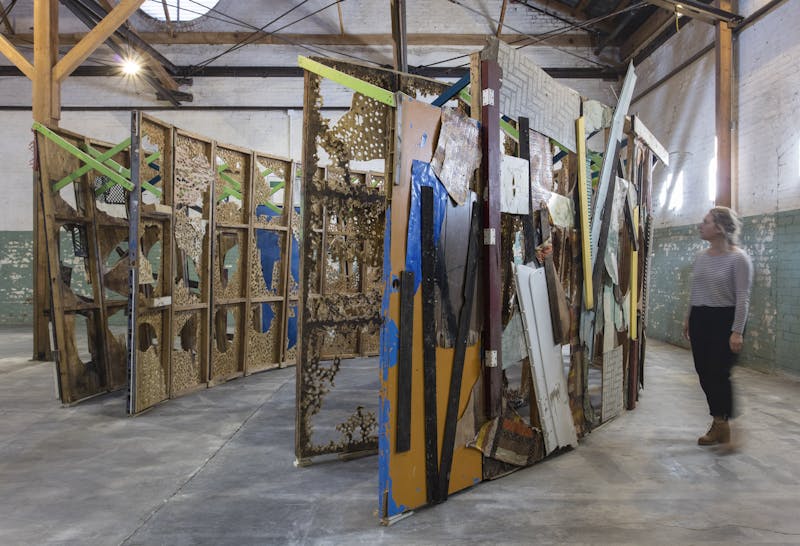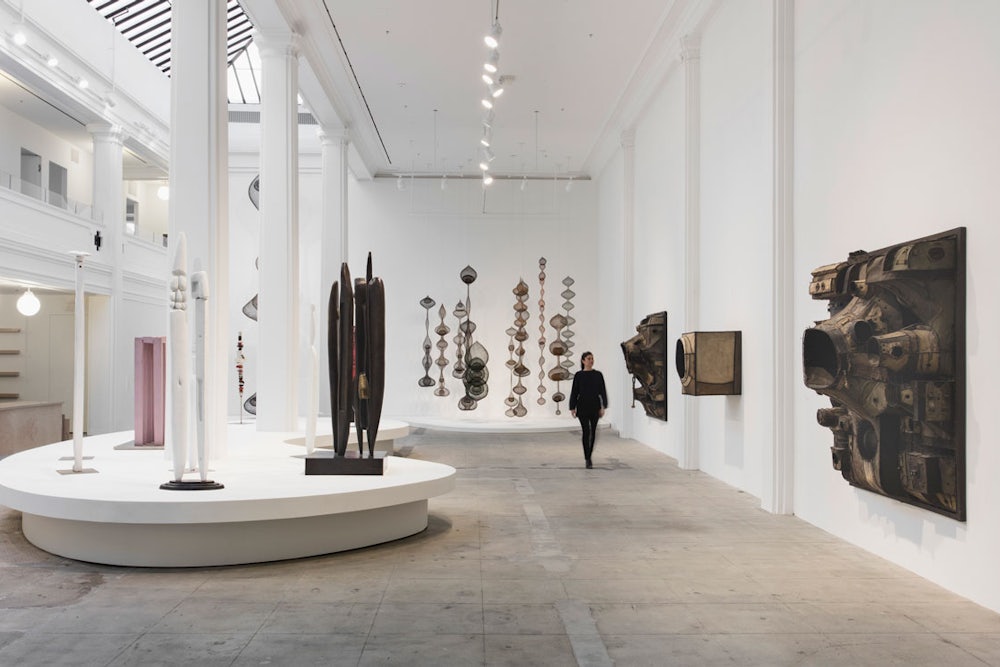Before it was called the Downtown Arts District, many more artists lived and worked in this stretch of central Los Angeles. The neighborhood was a rough-edged alternative for people in need of large, industrial spaces. A home for those willing to be Skid Row-adjacent and amenity-non-adjacent. But Los Angeles is making an attempt at urbanization, at feeling like a much denser city, and rapid gentrification has followed. Poketo, a newly arrived store in the Arts District, sells a designer chair for $1,225. Blacktop, the café down the street, is known for its $4 white coffee. And the new One Santa Fe, a luxury apartment complex, charges about $2,000 per month for a studio. To the few remaining holdovers in the area, this new art of commerce is at once alienating and welcome. Art Share L.A., a non-profit studio and gallery that provides affordable housing to 30 low-income artists, has seen an entire neighborhood of live-work spaces disappear. Still, “artists need people with money,” a longtime resident said.
The walkable Arts District is part of what’s envisioned as an urban corridor for L.A.: a growing web of galleries, shops, restaurants, and rental housing. In March, just six months after the Broad Museum began to draw zigzagging queues of visitors downtown, Hauser Wirth & Schimmel, the international mega-purveyor of contemporary art, opened what real estate developers might call another “anchor” establishment. The gallery spreads out over 112,000 square feet of a repurposed flourmill, a bank, and three warehouses on East Third Street. Throughout the complex, industrial residues peek out from new construction and design: old floor tile, red and yellow hazard paint, metal knobs and levers protruding from scabby walls. There are four separate galleries, a printed matter lab (for displaying light-sensitive papers and books), and a courtyard dotted with sculptures and communal tables. A long, covered breezeway reminiscent of a delivery ramp or loading dock now hosts installations, and several wall paintings by L.A. graffiti artists have been preserved or expanded. The space is undeniably beautiful. But its connections to the past are purely aesthetic, not emotional or cultural.

Known in six other cities as Hauser & Wirth, the Los Angeles gallery is marked by the addition of partner Paul Schimmel, who previously worked as chief curator of the Museum of Contemporary Art in downtown L.A., now across the street from the Broad. He and Jenni Sorkin, an art historian at the University of California, Santa Barbara, have assembled an ambitious first show: “Revolution in the Making: Abstract Sculpture by Women, 1947–2016.” The exhibition is a vast, encyclopedic survey of more than 100 works by three dozen artists. Just one in five of the exhibits are actually for sale; the rest are on loan from private collections, museums, or the artists themselves. Indeed, the show makes the gallery feel like a museum, with lengthy wall text (though Spanish-speaking Angelenos are out of luck) and an unusually long run—“Revolution in the Making” is on view through September. Amid local fears of gentrification and displacement, Hauser Wirth & Schimmel has launched an unimpeachable show: democratic and feminist.
The works are major, in some cases canonical. There are sculptures that act like paintings, sculptures that sit on the floor, and immersive installations. In the front room are older, well-known pieces: Louise Bourgeois’s spindly “Personnages” totems, the black-black, 3-D assemblages of Louise Nevelson, and Ruth Asawa’s woven-wire pendants dangling in the air. (In the printed matter room, an inspired selection of Bourgeois’s letters, papers, and early books are also on display.) The two north galleries take us forward from the 1960s, and include the monumental sculptures of Françoise Grossen—her twisted Manila-rope hanging, “Five Rivers” (1974)—and Magdalena Abakanowicz—her eight-foot-tall “Wheel With Rope” (1973). At the opposite end of the material spectrum are subtle, aerial works by Lygia Pape, whose “Ttéia 1, A” (1979/1997/1999), made of golden thread, looks like a music staff peeled off manuscript paper, and Senga Nengudi, whose “R.S.V.P. I” (1977/2003) weighs down pantyhose “V”s with sand at the pelvis, then stretches them into thin lines through the legs and reinforced toes, wall to wall.

Larger-scale sculptures, too, bear startling details. In a corner of North Gallery A sits a tall, dark-grey concrete wall. Cristina Iglesias’s “Untitled” (1993–97), curves toward the viewer like the hull of a ship but is in fact just one side of a giant “Y:” The inside arms of the “Y” consist of a metal wall facing and vaguely reflecting a faded European tapestry of the curly-wigged, pointy-shoed variety. What initially appeared to be a cold, Richard Serra-like cliff becomes a structural contradiction, by turns plush and hard-edged. (The exhibition’s catalog photo does not do it justice.)
In the East Gallery, the most industrial of the Hauser Wirth & Schimmel complex, sits another kind of wall, or sequence of walls, by Brooklyn-based artist Abigail Deville. “Intersection” (2014) is a psychological and literal passageway (you can walk through it) built of perforated plywood theater flats collaged with family photos and other intimate ephemera. The rough-hewn gallery plays up the labored nature of Deville’s work and its neighbors, including Lara Schnitger’s funny, S&M-styled “V-plunge” (2016) and Sonia Gomes’s “Torções Circulares” (2016), a series of fabric-and-wire tangles.
As New York Times art critic Holland Cotter wrote in his review of the show, all-women (or all-LGBT or all-African-American, etc.) exhibits can feel tokenistic, but do serve to “introduce new names, unseen work, understudied lives.” For Cotter, “Revolution in the Making” fails in this respect, since many of its artists are already well known. Nevertheless, Schimmel and Sorkin rightly argue in their catalog essay that, sculpture by women—even famous women—is underappreciated. “Sculpture has long been considered one of the most muscular of all mediums and therefore more suitable for men, a bias that persisted into the 1970s,” they write. This was among the many reasons “women pioneered conceptually driven artistic practices, including text-based work, photography, film, video, and performance,” which were cheaper, more accessible, and “not burdened by the weight of the past.” (Think Carolee Schneemann, Barbara Kruger, Marina Abramovic, et al.)


It’s fitting, then, to see so much womanly muscle flexed in a century-old flourmill. In Lee Bontecou’s mechanistic, protruding canvases or the enormous, graffiti-inspired fabric bundles of Shinique Smith, we witness the physical demands of sculpture—welding, carving, cutting, twisting, collaging, stitching, pouring, pulling, stuffing—none of it on a screen. The workaday remnants of the renovated space contribute to this appreciation, as does the reality of the gentrifying Arts District, once home to a creative proletariat. To its credit, Hauser Wirth & Schimmel has promised to provide an array of arts education and public programs, to be a good citizen “in a part of Los Angeles currently experiencing rapid renewal and growth,” its press release reads.
A few days after the gallery opened, visitor traffic had slowed to a pleasant trickle, laying bare another type of cultural labor. In every room of the Hauser Wirth & Schimmel complex, attendants dressed in black stood guard, protecting the artworks from unruly children and photography. Unlike in most museums and galleries, however, the sentinels weren’t professional security guards, but rather, young artists and art students with funky glasses, dyed hair, piercings, and stylish shoes. Was this a case of worker displacement, or a proper acknowledgment that artists, too, are part of the working class? One wondered, most of all: Where in Los Angeles could they afford to live?
